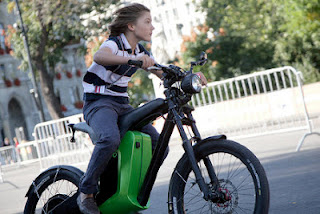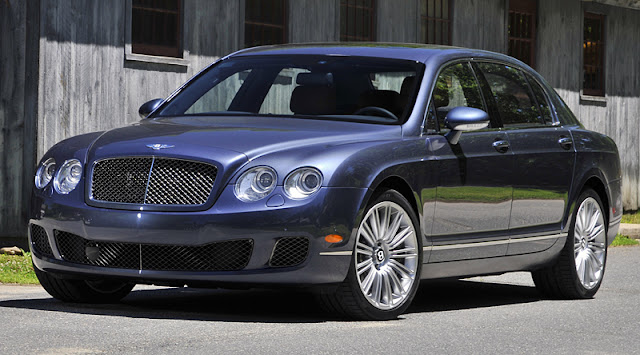 |
| This is a foldable electric bicycle. |
DEAR SERGEANT AL: I see a few weeks ago you addressed the
issues of buying an all-electric plug-in car. I’m thinking about getting an
electric plug-in bike. Will I need to get a license? I would figure that since
it doesn’t have an internal combustion engine, it has pedals, and it is
basically a bicycle that you don’t need a motor. Any advice? —PART EXERCISING DIMENTIALLY ALLEVIATES LAX
PUMPING INTO MORE PEDALING.
DEAR PEDAL PIMP: Ah, ah, ah, be very careful. Like
I was describing in my post last week about ticket insurance, the e-bike
market is another industry and demographic that is still in its infancy if not still in gestation. This is the rare exception of that case where just because it looks
like a duck, quacks like a duck, shifts like a duck, rides like a duck, and pedals like a duck,
you can convince yourself that in fact you have a duck, when actually after the first
time the police pull you over on your new bike you then realize you don’t have
a duck with tickets for unlicensed riding in your hand, if not having the bike
confiscated and vouchered. This was the same thinking that got lots of people
into trouble some 35 years ago during the energy crisis of the 70’s when people
went out like crazy and started buying mopeds made in China, Taiwan, Korea,
etc. and started riding them all over the place in this country without
licenses past the long lines at the gas pumps. Many had their moped riding
careers cut short abruptly either by ticket, injury, or death! Just because you
can switch the motor off and start pedaling doesn’t mean you can fool the
police that it can pass for a bike and not require you to have a license. We’re
not brain surgeons, but we’re certainly not stupid either!
Remember
this rule of thumb on whether you need a license to operate or you need to register a self-propelled vehicle: If the vehicle propels itself
in some way, whether by land, sea, or air, using any kind of oil, any kind
of gas, any other kind of liquid or substance (water too, i.e. hydrogen
power, or think “Doc” Brown and his DeLorean), electricity, wind (yes
wind like a fixed or rotating wing aircraft), or solar power to propel it, most
likely you need to document with the government either the vehicle itself, or at
least your ability to operate it based on proof submitted to a government agent
(road/written test or marine or aircraft operator’s license). Police all across
the country are getting wise to the electric bike phenomena, and they may not crack down on it in significant proportions yet like the 70’s moped craze
because:
1.
There aren’t that many e-bikes yet for the police to have the resolve
to crack down. E-bikes are more difficult to spot on the road than mopeds were years ago. People
haven’t been hurt or killed in substantive proportions yet for the will of the
people to make them start cracking down on illegal electric bikes in any
significant way. But this will change very soon as e-bikes proliferate.
2.
The laws haven’t yet adjusted to include e-bikes. There are only 15 states
so far that define and regulate e-bikes. Many local jurisdictions have stepped
in to either ban or approve e-bikes. States like New York outright ban them,
though they have pending legislation to define and regulate them.
3.
E-bikes beg for their own classification. They can go faster than a
regular bicycle, a bit slower than a car or a motorcycle on local roads, and about
as fast as a moped or scooter, but they aren’t powered by internal combustion,
so where should we put them? This is the dilemma that state legislatures across
the country are facing. The problem with e-bikes is that because they are
self-propelled and vary in their speed that they are being introduced into an
environment where they can be dangerous to cars, pedestrians and other bikes.
Because they can have a varying range in speed that falls into the realm of
both motor vehicles and bikes, they can cause more property damage and injuries
(and death) under many more circumstances than a regular bike. The following video might be funny to watch, especially if you're a guy, but it underscores how dangerous electric bikes can be:
SO my advice is to stay within the law as electric
bikes proliferate like missiles. When the police are ready to stop you, you can
pedal or electric right on by on Electric Avenue licensed and legal. Here are four issues you need to address
before you go out and buy an electric bicycle:
1. What kind of vehicle do I have? Know what kind of
classification your e-bike falls into under the law so that you know what kind
of documentation (license and/or registration) you may need. Check with your state to find out which
kind is which. Thirty-five states as of this writing do not have any definition
of what an e-bike is. In some states a
moped and a self propelled bike can be the same thing and have:
▪
Fully functional pedals for human
propulsion.
▪ An internal combustion engine producing
less than two gross brake horsepower with automatic transmission.
▪
An electric motor with or without
pedals.
Some
states like California make your bike OK to ride without a license depending on
how powerful or fast it can go. Some states like New York are super-strict in that
if it has any kind of motor you need a license to drive/ride it, period, and
e-bikes are BANNED. Here’s
California’s interpretation according to their handbook:
▪ The second type of moped has an
electric motor of less than 1,000 watts and cannot go above 20 mph on level
ground (even if assisted by human power). The motor must also stop when the
brakes are applied or starter switch released.
▪ This "20 mph"
classification of a moped may be driven without a license, proof of financial
responsibility, or a moped license plate. The driver need only be 16 years old
and wearing a properly fitting bicycle helmet.
▪ You can't ride your moped on freeways
or any type of bike path or trail, unless local law has given permission. You
can drive your moped in lanes designated for bicycles, but be considerate of
other bikers.
So here
your electric bike is good to ride in the Golden State, but watch out anywhere
else. Also remember this, in some cases, like in some cities, you need to check
with their ordinances to see if they allow electric bicycles on their roads and
paths without registering with them. Just because a state may allow you to ride
an electric bike, doesn’t necessarily mean that a town, county, or city may
make it OK.
2. What age do I have to be? The 15 states that
have laws about this are all over the place, ranging from ages 10-18. The rule
of thumb is that if you are old enough to get behind the wheel of a car, then
you’re good to go on a 2 or 3-wheeled self propelled vehicle as well. Usually
you must be 16 and older to drive a self propelled two or three wheeled vehicle
like an electric bike. CHECK WITH YOUR STATE.
3. Do I have to wear a helmet? Most likely yes. The
age ranges vary as they do for who can operate a self propelled 2 or 3-wheeled
vehicle. But if you don’t have to wear a helmet for a motorcycle in your state
there’s a chance you won’t have to for a bicycle (but this is a BAD idea, wear
one anyway). CHECK WITH YOUR STATE.
4. What happens when I run out of power? Very much like the
issues that face drivers with electric cars, once you’ve used all of your
range, you’re screwed. Like
I told readers in my electric car post, the battery issues with cars are
problematic, expect the same if not worse for bicycles as well. The technology
still needs tweaking, and because the batteries in bikes are smaller than they
are in cars, the ranges can be much worse if not as reliable. Remember that
with an electric car, a driver can call AAA and have the car quick-charged or towed
to a recharging station. If you run out of power with your bicycle however, it reverts
to a regular bike and thus, you’re governed by all the rules no differently
than an ordinary bicycle. That might mean you might not be able to bike in
places or distances that allow you to do so in electric mode. Remember that
some of these e-bikes can get up to speeds of up to 30-35 mph, so they can
cover more distances than a regular bike. That’s great to get to your destination,
but a potential for disaster for the return trip if you’re out of range or
juice. You can plug in your laptop or cellphone at Starbucks, I don’t know if
that’ll wash with your bike. So if I were you PEDAL PIMP, I’d watch where you go with your range more so than with an electric
car, and make sure that if necessary you can pedal your way back, otherwise if
the hills are too steep or the distance too far, you might have to call for a
ride or bus it or cab it home!
PEDAL PIMP as it stands now, there is no rhyme to any reason when it comes to
purchasing and riding an electric bicycle. Everybody from the manufacturers to
government to consumers is all over the place when it comes to making, selling,
buying, and riding e-bikes. Every state has its own rules, or no rules that can
be interpreted as skies the limit or a complete ban, so my best suggestion is
to look up your state’s website or call your local DMV office for the right
information. I’m letting you go with a WARNING: it may be the green thing to do
to ride an electric bike, but any self-propelled vehicle can be DANGEROUS to
you and others around you, no matter how fast or slow it goes, this is why most
jurisdictions regulate such things to insure that they are operated safely,
once they get their act together if they ever do. Good luck with your electric
bike shopping, and drive and ride safely!
Suggested
Reading:
What is a CARMAGEDDON and when will
it happen?
Am I allowed to walk on a highway?
Suggested Reading:
The
definition of a “Concours” car and event
Suggested Reading:
Suggested Reading:
What is the new national terror alert warning?
Taking photographs at off-limits tourist landmarks .




























